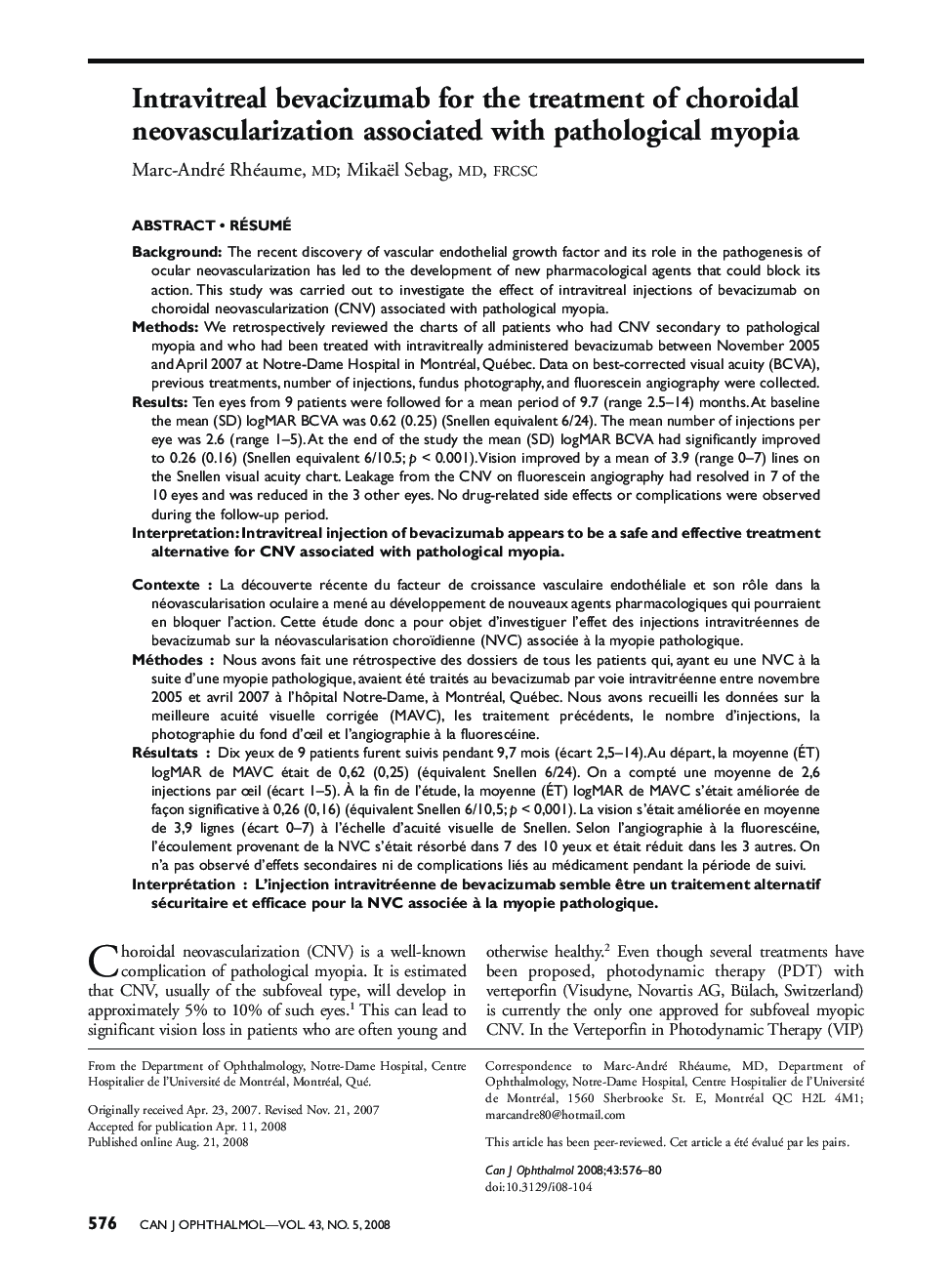| Article ID | Journal | Published Year | Pages | File Type |
|---|---|---|---|---|
| 4010027 | Canadian Journal of Ophthalmology / Journal Canadien d'Ophtalmologie | 2008 | 5 Pages |
Background: The recent discovery of vascular endothelial growth factor and its role in the pathogenesis of ocular neovascularization has led to the development of new pharmacological agents that could block its action. This study was carried out to investigate the effect of intravitreal injections of bevacizumab on choroidal neovascularization (CNV) associated with pathological myopia.Methods: We retrospectively reviewed the charts of all patients who had CNV secondary to pathological myopia and who had been treated with intravitreally administered bevacizumab between November 2005 and April 2007 at Notre-Dame Hospital in Montréal, Québec. Data on best-corrected visual acuity (BCVA), previous treatments, number of injections, fundus photography, and fluorescein angiography were collected.Results: Ten eyes from 9 patients were followed for a mean period of 9.7 (range 2.5–14) months.At baseline the mean (SD) logMAR BCVA was 0.62 (0.25) (Snellen equivalent 6/24). The mean number of injections per eye was 2.6 (range 1–5). At the end of the study the mean (SD) logMAR BCVA had significantly improved to 0.26 (0.16) (Snellen equivalent 6/10.5; p < 0.001).Vision improved by a mean of 3.9 (range 0–7) lines on the Snellen visual acuity chart. Leakage from the CNV on fluorescein angiography had resolved in 7 of the 10 eyes and was reduced in the 3 other eyes. No drug-related side effects or complications were observed during the follow-up period.Interpretation: Intravitreal injection of bevacizumab appears to be a safe and effective treatment alternative for CNV associated with pathological myopia.
RésuméContexte: La découverte récente du facteur de croissance vasculaire endothéliale et son rôle dans la néovascularisation oculaire a mené au développement de nouveaux agents pharmacologiques qui pourraient en bloquer l’action. Cette étude donc a pour objet d’investiguer l’effet des injections intravitréennes de bevacizumab sur la néovascularisation choroïdienne (NVC) associée à la myopie pathologique.Méthodes: Nous avons fait une rétrospective des dossiers de tous les patients qui, ayant eu une NVC à la suite d’une myopie pathologique, avaient été traités au bevacizumab par voie intravitréenne entre novembre 2005 et avril 2007 à l’hôpital Notre-Dame, à Montréal, Québec. Nous avons recueilli les données sur la meilleure acuité visuelle corrigée (MAVC), les traitement précédents, le nombre d’injections, la photographie du fond d’œil et l’angiographie à la fluorescéine.Résultats: Dix yeux de 9 patients furent suivis pendant 9,7 mois (écart 2,5–14).Au départ, la moyenne (ÉT) logMAR de MAVC était de 0,62 (0,25) (équivalent Snellen 6/24). On a compté une moyenne de 2,6 injections par œil (écart 1–5). À la fin de l’étude, la moyenne (ÉT) logMAR de MAVC s'était améliorée de façon significative à 0,26 (0,16) (équivalent Snellen 6/10,5; p <. La vision s'était améliorée en moyenne de 3,9 lignes (écart 0–7) à l’échelle d’acuité visuelle de Snellen. Selon l’angiographie à la fluorescéine, l’écoulement provenant de la NVC s'était résorbé dans 7 des 10 yeux et était réduit dans les 3 autres. On n'a pas observé d’effets secondaires ni de complications liés au médicament pendant la période de suivi.Interprétation: L’injection intravitréenne de bevacizumab semble être un traitement alternatif sécuritaire et efficace pour la NVC associée à la myopie pathologique.
